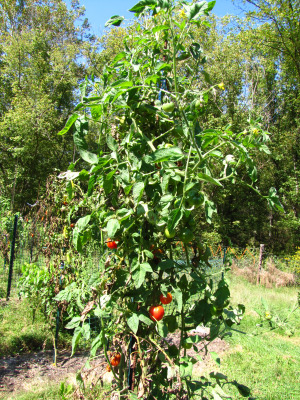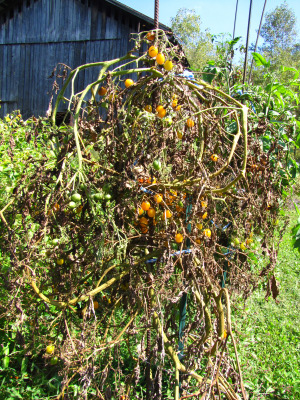
Tomato experiment conclusions
 You
might remember that I planted tomato
islands and late tomatoes in various parts of the
garden in hopes of getting a crop even if the blight hit my main tomato
patch. I regret to inform you that the tomato islands didn't do
any good. In fact, since I planted the "islands" on the shady
side of the garden to get them as far away from the main tomato patch
as possible, once the blight hit, it wiped out the loner plants even
faster.
You
might remember that I planted tomato
islands and late tomatoes in various parts of the
garden in hopes of getting a crop even if the blight hit my main tomato
patch. I regret to inform you that the tomato islands didn't do
any good. In fact, since I planted the "islands" on the shady
side of the garden to get them as far away from the main tomato patch
as possible, once the blight hit, it wiped out the loner plants even
faster.
On the other hand, the
idea of succession planting tomatoes has merit. I planted a
yellow roma from seed in our main tomato patch at the same time I
transplanted in the seedlings. Although that roma did catch the
blight from its neighbors, its youthful vigor somehow helped it out,
and the late roma is now producing more fruits than its neighbors.
 My supposedly blight
resistant tommy-toe,
on the other hand, seems to be more susceptible to one of our diseases
(maybe the septaria leaf spot?) than its neighbors, so it's actually
doing worse, not better. Meanwhile, the Blondkopfchen tommy-toe
that I thought would do well in blight situations is the first of our
tomato plants to become totally defoliated by blight --- little yellow
fruits are slowly ripening on a dead vine. This year, Stupice
seems to be our blight-free winner, putting out new green growth
despite shrivelled bottom leaves.
My supposedly blight
resistant tommy-toe,
on the other hand, seems to be more susceptible to one of our diseases
(maybe the septaria leaf spot?) than its neighbors, so it's actually
doing worse, not better. Meanwhile, the Blondkopfchen tommy-toe
that I thought would do well in blight situations is the first of our
tomato plants to become totally defoliated by blight --- little yellow
fruits are slowly ripening on a dead vine. This year, Stupice
seems to be our blight-free winner, putting out new green growth
despite shrivelled bottom leaves.
Next year, I plan to do
away with the most blight-prone roma varieties, to continue my pruning
campaign and
succession planting, and to plant all of my tomatoes in the sunniest
part of the garden. I'll also continue planting half a dozen or
more species of eating tomatoes, figuring that at least one of them
will be resistant to that year's fungal diseases. Meanwhile, we
continue to eat as many fresh tomatoes as possible to store up those
fond memories until next July.
Want more in-depth information? Browse through our books.
Or explore more posts by date or by subject.
About us: Anna Hess and Mark Hamilton spent over a decade living self-sufficiently in the mountains of Virginia before moving north to start over from scratch in the foothills of Ohio. They've experimented with permaculture, no-till gardening, trailersteading, home-based microbusinesses and much more, writing about their adventures in both blogs and books.
Want to be notified when new comments are posted on this page? Click on the RSS button after you add a comment to subscribe to the comment feed, or simply check the box beside "email replies to me" while writing your comment.

I wonder if there isn't anything you can do about fungi, barring say a fully enclosed glasshouse with air filtration &c.
If the bottom leaves catch the fungal diseases first, is that because they're close to the ground, or because the're close to the roots? To do something about it you'd need to know more about the route of infection. Maybe then it is possible to do something about it.
Just a thought, but would e.g. glass or clear plastic film barriers between the plants do any good to keep plants from infectiong their neighbors?
With modern genetics and breeding techniques one would expect that breeds could be improved to be more disease resistant.
Roland --- I was surprised too when I read that despite lots of breeding, no one has really developed resistant varieties or solid ways to combat the blight without chemicals. I think that part of the problem is that there are so many different fungal blights out there --- I saw from my own varieties that if you choose tomatoes resistant to late blight, they can be more sensitive to another fungus.
The blight does sometimes come from the soil, but it also can travel through the air for a mile or more during wet weather. That's the real trouble --- you can't stay away from it, even if you completely blocked the tomatoes off from the soil. I think that the bottom leaves tend to get the blight first partly because the blight can be in the soil, but more because that is the wettest part of the plant. Tomato fungi thrive on damp, so the longer it takes for leaves to dry out, the more the blight spreads.
The big organic farm we visited a few weeks ago tried to grow tomatoes in hoop houses, hoping that the plastic barrier would keep the blight from getting to the plants. And it did work, but then the tomatoes came down with another mold (can't remember which offhand) related to greenhouse conditions. Tomatoes are just picky! Luckily, we get a good run in, and then we start getting sick of tomatoes about the time they die back. (Only three weeks until the frost, so I suspect we will have ripe tomatoes all the way through.)
Edward --- I'm curious to hear that you had good luck moving the tomatoes to another part of your yard. I've read (and my experience shows) that the spores can travel a very long way. Maybe you found a sunnier spot that helped the leaves dry faster?
Some time ago, I saw a fragment on TV about a huge greenhouse in the UK used for growing tomatoes. IIRC, they didn't use pesticides and such but relied on air filters and strict hygiene protocols to protect the plants from infection.
Googling for "organic greenhouse tomato" I found some interesting articles likes this one on ATTRA. Since they deal with sustainable agriculture, I guess you know about them already.
It's interesting to read how much trouble you have to go through. It sounds like the hygiene protocols you'd find in a hospital!
Have you ever thought about cooperating with a local college that teaches agriculture?
You could probably teach them something about sustainability, and they have information available and possibly students looking for assignments.